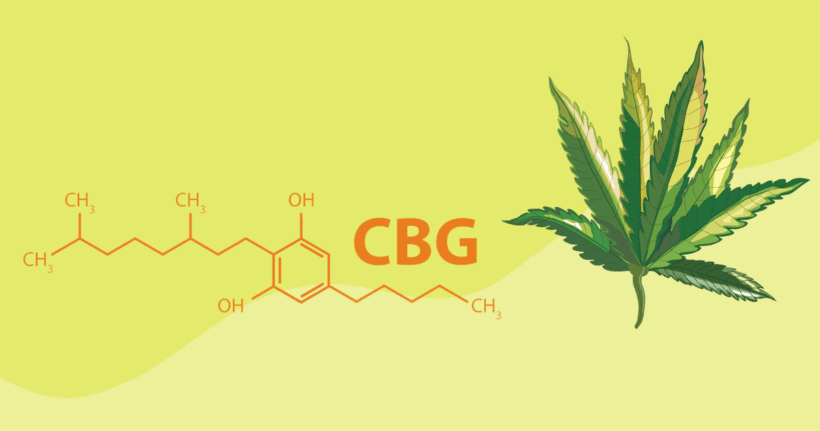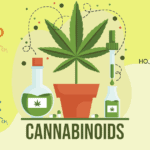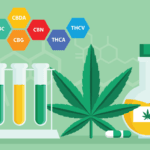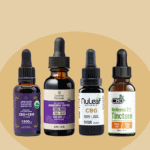Cannabigerol (CBG) is a cannabinoid found in cannabis. It’s considered a minor cannabinoid because its levels are usually low in comparison to CBD and THC.
CBG appears to have a long list of potential health benefits, some of which differ from CBD. It’s growing particularly popular for daytime use thanks to the belief that CBG enhances energy and mood.
Table of Contents
CBG’s Origins
CBG comes from cannabigerolic acid (CBGa), popularly referred to as the “mother of all cannabinoids” because most cannabinoids are derived from it (1). CBGa decarboxylates (breaks down when exposed to heat) into CBG.
But since enzymes in cannabis turn most CBGa into THCa and CBDa, the parent molecules of THC and CBD, there isn’t much left over to convert into CBG. That’s why most cannabis plants have less than 1% CBG, although some strains, like White CBG, are bred for higher levels.
Another way to get more CBG is to harvest cannabis earlier while it still has high concentrations of CBGa (which can then be decarboxylated into CBG).
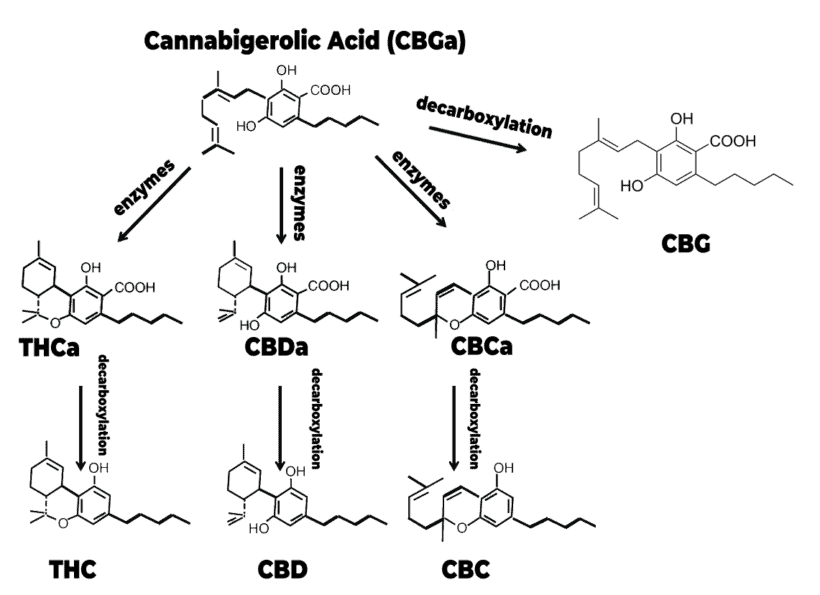
How Does CBG Differ from CBD?
| CBG | CBD | |
| Intoxicating? | No | No |
| Main benefits | Anti-inflammatory, pain relief, neuroprotective, appetite stimulant, boosting energy & mood* | Anti-inflammatory, sleep aid, pain relief, neuroprotective, appetite suppressant, anti-seizure, anti-anxiety, anti-nausea, anticancer, antipsychotic |
| How it works | CB1 & CB2 receptors, FAAH enzyme, blocking serotonin receptor, TRP channels, a2 adrenergic receptor | FAAH enzyme, activating serotonin receptor, TRP channels, and more |
*Anecdotally, many people claim to experience increased energy, focus, and a better mood with CBG products, but there’s no research evidence yet
CBG has similarities with CBD:
- Both are non-intoxicating cannabinoids, so they won’t get you high
- They have some similar effects, like anti-inflammatory and pain-relieving properties (2)
But CBG also differs from CBD in some ways:
- CBG may increase appetite, whereas CBD seems to lower it
- Levels of CBG in cannabis are generally much lower than CBD
- CBG appears to block serotonin 5HT1a receptors, whereas CBD seems to activate them
CBG Effects & Benefits
CBG has many potential health benefits. Although it’s seen less research than CBD, early studies have shown promising results: (3)
- Anti-inflammatory. CBG improved inflammatory bowel disease in a mouse study and had anti-inflammatory effects in a petri dish study of rheumatoid arthritis (4, 5).
- Antioxidant. Studies suggest that CBG has antioxidant effects that are comparable to vitamin E.
- Neuropathic pain. A 2022 study in mice reported that CBG may relieve neuropathic pain (6).
- Appetite stimulant. CBG improved appetite in rats in a 2016 study (7).
- Neuroprotection. Animal studies report that CBG can help with multiple sclerosis (MS) and protect neurons from Huntington’s disease (8). A 2019 study also found that combining CBD with CBG improved neuroinflammation better than either one alone, providing further evidence for the entourage effect (9).
- Glaucoma. CBG helped reduce intraocular pressure and had other beneficial effects in a 2009 study of cats (10).
- Antibacterial & antimicrobial. Out of multiple cannabinoids, CBG had some of the most potent antibacterial effects against antibiotic-resistant bacteria (11). It also had stronger topical antimicrobial effects than CBD (12).
- Anticancer. Early studies suggest that CBG may fight cancer cells.
- Skin disorders. In one 2023 clinical study, CBG serum improved skin redness and hydration in 20 people and showed anti-inflammatory effects in isolated skin cells (13)
- CBG relieved pain and promoted bone healing in mice with bone fractures (14)
- Bladder issues. CBG may reduce bladder contractions.
One 2021 survey of 121 cannabis users also found that CBG-rich cannabis was most commonly used to help with anxiety (51.2% of participants), chronic pain (40.9%), depression (33.1%), and insomnia or poor sleep (30.7%).
Most of the study participants rated their symptoms as much or very much improved, and 74% said they preferred CBG-rich cannabis over prescription meds for pain, 80% for depression, 73% for insomnia, and 78% for anxiety (15).
But while these findings are interesting, it’s difficult to isolate the effects of CBG since cannabis also contains THC and many other active compounds.
The bottom line is that more human studies are needed to understand CBG’s therapeutic potential fully.
How Does CBG Work?
Scientists have uncovered several ways that CBG produces its effects: (1)
- Interacting with CB1 and CB2 receptors of the endocannabinoid system (ECS), but not as strongly as THC.
- Suppressing FAAH, an enzyme that breaks down the endocannabinoid anandamide, but not as strongly as CBD (16).
- Interacting with TRP channels, which are involved in pain and inflammation.
- Strongly interacting with the a2 adrenergic receptor, which could have sedative, antihypertensive, and pain-relieving effects.
- Blocking the 5-HT1a receptor (the opposite effect of CBD), which means it may interact with SSRI antidepressants and other medicines that target serotonin.
- Interacting with PPARγ receptors.
This wide variety of effects (plus whatever we don’t yet know) highlights the therapeutic potential of CBG.
Safety & Side Effects
More research on CBG’s safety is needed. The survey of CBG-rich cannabis reported minor side effects like dry mouth, sleepiness, increased appetite, and dry eyes. But we can’t attribute these effects to CBG alone since cannabis contains many other active compounds (15).
CBG might also interact with some drugs, so it’s important to talk to your doctor if you’re taking any prescription medications.
CBG Dosage
There’s no one-size-fits-all dosage for CBG or any cannabinoid. It depends on many factors, like your body weight, genetics, and the type of product you’re using.
The best approach is to “start low and go slow,” gradually increasing your dosage until you find the amount that provides the desired effects (17). Another option is to start with the dosage suggested by your product.
My Experience With CBG
I’ve tested dozens of CBG oils, gummies, and capsules. Most made me feel relaxed and calm (similar to CBD) and gave a noticeable mood boost and a bit of energy. Some people also report improved focus from CBG products, but I haven’t experienced that.
I find that CBG products are ideal for daytime use because of their stimulating effects, which is why most CBD brands market them that way.
I usually take CBG in the morning or around lunchtime to boost my productivity and motivation, especially if I feel tired or sleepy.

Shopping for & Using CBG Products
CBG products are popular and offered by many CBD brands. You can choose from CBG oils, capsules, gummies, vapes, topicals, and more.
Generally speaking, you’ll come across three kinds of CBG formulas:
- Pure CBG isolate without any other cannabinoids
- A combination of pure CBG and CBD
- A full-spectrum CBD product with added CBG, usually at a 1:1 or 1:2 ratio to CBD
I recommend going for full-spectrum products; they offer greater benefits than any isolated cannabinoid, thanks to the entourage effect.
In particular, full-spectrum CBG oil is the best option for most people because tinctures are cost-effective, absorb well, have long-lasting effects, and make it easy to change your dose.
As a final tip, remember that cannabinoids affect everyone differently. Although CBG is best known as a stimulating cannabinoid, I have read some reviews saying CBG helps with sleep. So you’ll have to try CBG and see how it affects you.
Sources
- Nachnani, Rahul, Wesley M. Raup-Konsavage, and Kent E. Vrana. “The pharmacological case for cannabigerol.” Journal of Pharmacology and Experimental Therapeutics 376.2 (2021): 204-212.
- Cather, Jennifer Clay, and J. Christian Cather. “Cannabidiol primer for healthcare professionals.” Baylor University Medical Center Proceedings. Vol. 33. No. 3. Taylor & Francis, 2020.
- Calapai, Fabrizio, et al. “Pharmacological Aspects and Biological Effects of Cannabigerol and Its Synthetic Derivatives.” Evidence-Based Complementary and Alternative Medicine 2022 (2022).
- Borrelli, Francesca, et al. “Beneficial effect of the non-psychotropic plant cannabinoid cannabigerol on experimental inflammatory bowel disease.” Biochemical pharmacology 85.9 (2013): 1306-1316.
- Lowin, Torsten, et al. “Anti-inflammatory effects of cannabigerol in rheumatoid arthritis synovial fibroblasts and peripheral blood mononuclear cell cultures are partly mediated by TRPA1.” International Journal of Molecular Sciences 24.1 (2023): 855.
- Sepulveda, Diana E., et al. “Cannabigerol (CBG) attenuates mechanical hypersensitivity elicited by chemotherapy‐induced peripheral neuropathy.” European Journal of Pain 26.9 (2022): 1950-1966.
- Brierley, Daniel I., et al. “Cannabigerol is a novel, well-tolerated appetite stimulant in pre-satiated rats.” Psychopharmacology 233 (2016): 3603-3613.
- Fleisher-Berkovich, Sigal, et al. “Therapeutic potential of phytocannabinoid cannabigerol for multiple sclerosis: Modulation of microglial activation in vitro and in vivo.” Biomolecules 13.2 (2023): 376.
- Mammana, Santa, et al. “Could the combination of two non-psychotropic cannabinoids counteract neuroinflammation? Effectiveness of cannabidiol associated with cannabigerol.” Medicina 55.11 (2019): 747.
- COLASANTI, BRENDA K. “A comparison of the ocular and central effects of Δ9-tetrahydrocannabinol and cannabigerol.” Journal of Ocular Pharmacology and Therapeutics 6.4 (1990): 259-269.
- Appendino, Giovanni, et al. “Antibacterial cannabinoids from Cannabis sativa: a structure− activity study.” Journal of natural products 71.8 (2008): 1427-1430.
- Luz-Veiga, Mariana, et al. “Cannabidiol and cannabigerol exert antimicrobial activity without compromising skin microbiota.” International Journal of Molecular Sciences 24.3 (2023): 2389.
- Perez, Eduardo, et al. “In Vitro and Clinical Evaluation of Cannabigerol (CBG) Produced via Yeast Biosynthesis: A Cannabinoid with a Broad Range of Anti-Inflammatory and Skin Health-Boosting Properties.” Molecules 27.2 (2022): 491.
- Khajuria, Deepak Kumar, et al. “Cannabidiol and cannabigerol, nonpsychotropic cannabinoids, as analgesics that effectively manage bone fracture pain and promote healing in mice.” Journal of Bone and Mineral Research (2023).
- Russo, Ethan B., et al. “Survey of patients employing cannabigerol-predominant cannabis preparations: Perceived medical effects, adverse events, and withdrawal symptoms.” Cannabis and Cannabinoid Research 7.5 (2022): 706-716.
- Jastrząb, Anna, Iwona Jarocka-Karpowicz, and Elżbieta Skrzydlewska. “The origin and biomedical relevance of cannabigerol.” International journal of molecular sciences 23.14 (2022): 7929.
- Lucas, Catherine J., Peter Galettis, and Jennifer Schneider. “The pharmacokinetics and the pharmacodynamics of cannabinoids.” British journal of clinical pharmacology 84.11 (2018): 2477-2482.

Gleb is a freelance writer from Vancouver, Canada specializing in CBD and cannabis. He’s read thousands of studies on CBD and other supplements, helping him translate complex science into plain language. Gleb has tried and reviewed dozens of CBD brands and products, written third-party testing reports, and knows the CBD industry inside and out. When not writing, he likes to kickbox, travel, and tell everyone how awesome intermittent fasting is.

